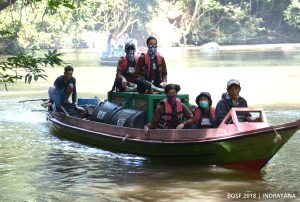Releases

RELEASES - The Third "R" of "Red Ape Relief"
After a long period of rehabilitation and supervision, the orangutans are ready to be released into carefully chosen areas in the wild. The release sites must meet a number of criteria: they must be free from human activity; the forest must have diversity of fruits and plants that can feed the orangutans; and the site also has to be in the area of Borneo or Sumatra that the orangutans originate from in order to avoid genetic mix up with other wild populations.
 Once such an area has been found, the difficult task of getting the orangutans to the site begins. It is by definition almost always a very remote area. The journey to a release site includes hours or days of travel by trucks and by boats. Helicopters or small planes that can land on nearby rivers are sometimes used. Several orangutans are released at the same time, so they can choose to stay near each other until they are comfortable in the forest. Each release operation is a huge undertaking. The releases require intense planning and logistical considerations. Large teams, including veterinarians, make the journey. Taking into account all the supplies, petrol, helicopter and boat rental, and staff salaries makes each operation very costly. It can cost upwards of USD $5,000 USD to release an orangutan.
Once such an area has been found, the difficult task of getting the orangutans to the site begins. It is by definition almost always a very remote area. The journey to a release site includes hours or days of travel by trucks and by boats. Helicopters or small planes that can land on nearby rivers are sometimes used. Several orangutans are released at the same time, so they can choose to stay near each other until they are comfortable in the forest. Each release operation is a huge undertaking. The releases require intense planning and logistical considerations. Large teams, including veterinarians, make the journey. Taking into account all the supplies, petrol, helicopter and boat rental, and staff salaries makes each operation very costly. It can cost upwards of USD $5,000 USD to release an orangutan.
 Once the release site is reached, the team carries each transport crate deep into the forest. There is much celebration as each crate is opened and the orangutan runs out and scrambles up the nearest tree to true freedom. As the orangutans are released into the wild, all that is left is to hope that the rehabilitation process has helped to make each of them strong and skillful enough to survive on their own. Post-release monitoring teams track the orangutans for up to 18 months to assure they are adapting to their new home. Fortunately, most of the orangutans who have been released are doing well.
Once the release site is reached, the team carries each transport crate deep into the forest. There is much celebration as each crate is opened and the orangutan runs out and scrambles up the nearest tree to true freedom. As the orangutans are released into the wild, all that is left is to hope that the rehabilitation process has helped to make each of them strong and skillful enough to survive on their own. Post-release monitoring teams track the orangutans for up to 18 months to assure they are adapting to their new home. Fortunately, most of the orangutans who have been released are doing well.
 It is always hard for the staff to say goodbye to an orangutan with whom they have spent many years. It's essentially no different than saying goodbye to a friend. But it is also incredibly rewarding to see that an orangutan rescued from a dire situation can be successfully released into the wild to live a normal life. Our colleagues will tell you that the moment an orangutan is returned to their rightful home in the jungle, it makes all the hard work worthwhile.
It is always hard for the staff to say goodbye to an orangutan with whom they have spent many years. It's essentially no different than saying goodbye to a friend. But it is also incredibly rewarding to see that an orangutan rescued from a dire situation can be successfully released into the wild to live a normal life. Our colleagues will tell you that the moment an orangutan is returned to their rightful home in the jungle, it makes all the hard work worthwhile.
Our partners that cary out ongoing release operations include: the Borneo Orangutan Survival Foundation (BOSF), Sumatran Orangutan Conservation Programme (SOCP); and International Animal Rescue Indonesia (YIARI). In the decade between 2012 and 2022, BOSF successfully released 500 orangutans! Learn more about BOSF releases here.
There must be suitable habitat in which to release the orangutans in the future. Learn about the next "R" of orangutan conservation, Reforestation.
The 5 Rs of Red Ape Relief
Rescues
Rehabilitation
Releases (back to the top)
Retirement
Reforestation
